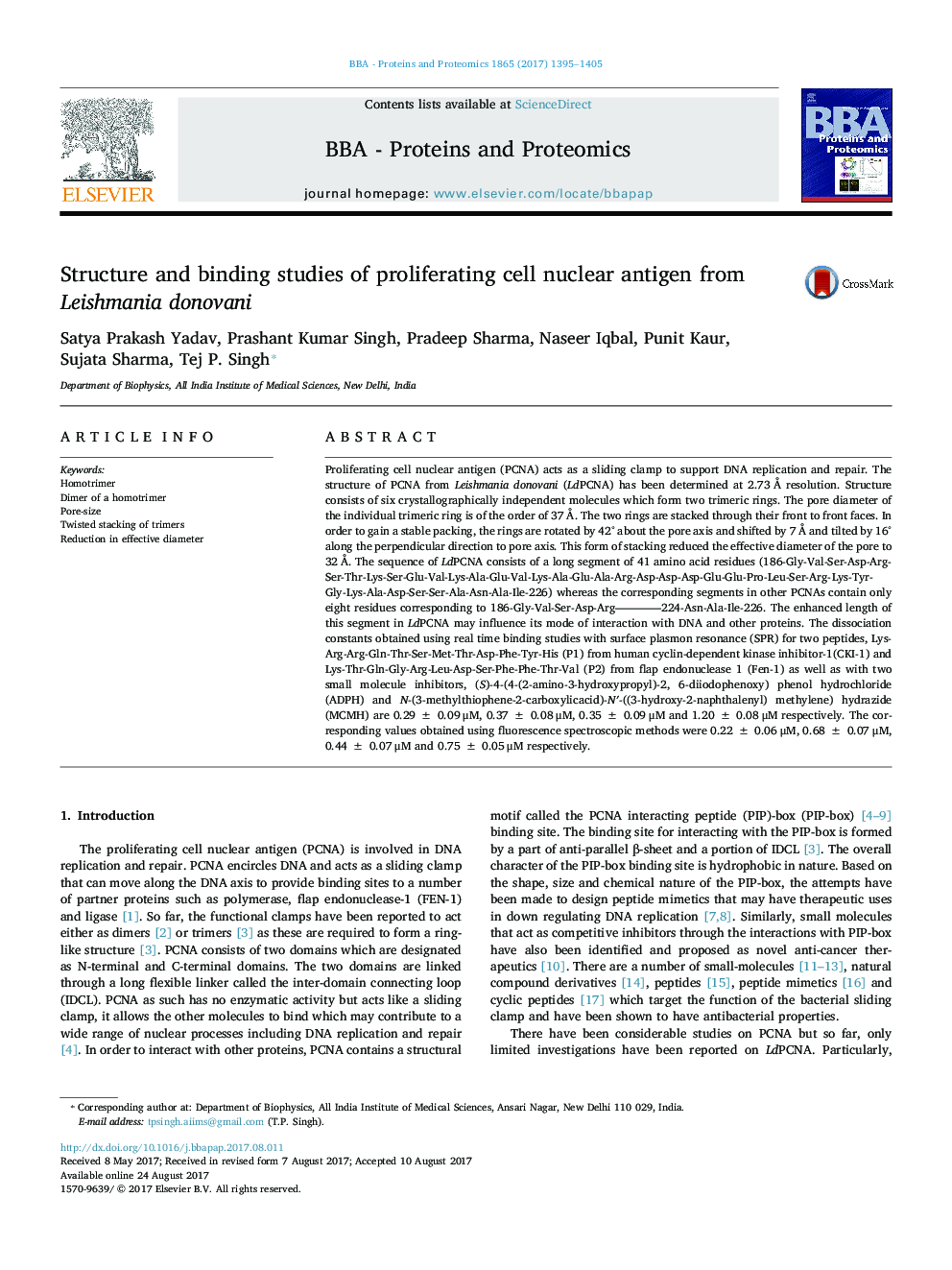| کد مقاله | کد نشریه | سال انتشار | مقاله انگلیسی | نسخه تمام متن |
|---|---|---|---|---|
| 5131870 | 1378779 | 2017 | 11 صفحه PDF | دانلود رایگان |

- Proliferating cell nuclear antigen (PCNA) encircles DNA and acts as a sliding clamp.
- PCNA acts to promote the DNA replication and repair.
- Structure of PCNA from Leishmania donovani has six molecules in the asymmetric unit.
- Six molecules form two trimeric rings which are stacked to form a stable assembly.
- The two stacked rings are twisted, translated and tilted with respect to each other.
Proliferating cell nuclear antigen (PCNA) acts as a sliding clamp to support DNA replication and repair. The structure of PCNA from Leishmania donovani (LdPCNA) has been determined at 2.73 à resolution. Structure consists of six crystallographically independent molecules which form two trimeric rings. The pore diameter of the individual trimeric ring is of the order of 37 à . The two rings are stacked through their front to front faces. In order to gain a stable packing, the rings are rotated by 42° about the pore axis and shifted by 7 à and tilted by 16° along the perpendicular direction to pore axis. This form of stacking reduced the effective diameter of the pore to 32 à . The sequence of LdPCNA consists of a long segment of 41 amino acid residues (186-Gly-Val-Ser-Asp-Arg-Ser-Thr-Lys-Ser-Glu-Val-Lys-Ala-Glu-Val-Lys-Ala-Glu-Ala-Arg-Asp-Asp-Asp-Glu-Glu-Pro-Leu-Ser-Arg-Lys-Tyr-Gly-Lys-Ala-Asp-Ser-Ser-Ala-Asn-Ala-Ile-226) whereas the corresponding segments in other PCNAs contain only eight residues corresponding to 186-Gly-Val-Ser-Asp-Arg------224-Asn-Ala-Ile-226. The enhanced length of this segment in LdPCNA may influence its mode of interaction with DNA and other proteins. The dissociation constants obtained using real time binding studies with surface plasmon resonance (SPR) for two peptides, Lys-Arg-Arg-Gln-Thr-Ser-Met-Thr-Asp-Phe-Tyr-His (P1) from human cyclin-dependent kinase inhibitor-1(CKI-1) and Lys-Thr-Gln-Gly-Arg-Leu-Asp-Ser-Phe-Phe-Thr-Val (P2) from flap endonuclease 1 (Fen-1) as well as with two small molecule inhibitors, (S)-4-(4-(2-amino-3-hydroxypropyl)-2, 6-diiodophenoxy) phenol hydrochloride (ADPH) and N-(3-methylthiophene-2-carboxylicacid)-Nâ²-((3-hydroxy-2-naphthalenyl) methylene) hydrazide (MCMH) are 0.29 ± 0.09 μM, 0.37 ± 0.08 μM, 0.35 ± 0.09 μM and 1.20 ± 0.08 μM respectively. The corresponding values obtained using fluorescence spectroscopic methods were 0.22 ± 0.06 μM, 0.68 ± 0.07 μM, 0.44 ± 0.07 μM and 0.75 ± 0.05 μM respectively.
The structure of the proliferating cell nuclear antigen from Leishmania donovani (LdPCNA) consists of six protein molecules which form two trimeric rings, each having a pore diameter of 37 à . The two rings are twisted by 42° to stack as a stable dimeric assembly. The effective pore diameter of the assembly is of the order of 32 à . This may influence the interactions of LdPCNA with DNA as well as that of other partner proteins.151
Journal: Biochimica et Biophysica Acta (BBA) - Proteins and Proteomics - Volume 1865, Issue 11, Part A, November 2017, Pages 1395-1405